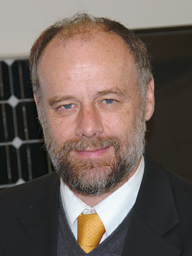Speaker | Prof. Richard Corkish Head, School of Photovoltaic and Renewable Energy Engineering and COO, Australia-US Institute for Advanced Photovoltaics, The University of New South Wales |  |
| Brief Bio of the Speaker | Richard Corkish graduated with distinction as a Communications Engineer from the Royal Melbourne Institute of Technology in 1986 then worked with the CSIRO Division of Radiophysics on satellite earth-station antenna design and testing before studying for the PhD degree under the supervision of Professor Martin Green at the University of New South Wales’ Centre for Photovoltaic Devices and Systems. After a brief period working with the Rainbow Power Company in Nimbin he has worked on solar cell theory, applications and education at UNSW. He has been Head of School at the School of Photovoltaic and Renewable Energy Engineering, UNSW since 2003 and, since 2013, become Centre General Manager of the Australian Centre for Advanced Photovoltaics, which represents the Australian partners in the US-Australia Institute for Advanced Photovoltaics, supported by the Australian Solar Institute and the Australian Renewable Energy Agency. |
Abstract | The University of New South Wales has carried out silicon solar cell research since the mid 1970s, when it achieved world recognition. The UNSW solar cell research group has been one of the global leaders in research and new and, since 2000, pioneered specialised undergraduate education in photovoltaics engineering. The Photovoltaics and Solar Energy undergraduate program is a four year full-time Engineering undergraduate program covering device theory; photovoltaic technology and manufacturing; photovoltaic applications and system design; policy and analysis and modelling; renewable energy technologies and sustainable energy. A partner undergraduate program, Renewable Energy Engineering, encompasses a broader range of renewable energy technologies including solar thermal, wind, biomass, solar architecture and the design of energy efficient buildings. The School also offers postgraduate coursework programs and two research programs: a Masters by Research and a Doctor of Philosophy. The presentation will explain the programs and recent developments. The School’s photovoltaics devices research has five main strands. Firstly, it continues to improve the commercially dominant technology of silicon wafer solar cells. For example, strong advances are continuing to be made in selective emitter technologies in collaboration with Asian companies and a new hydrogenation advances promise the ability to make excellent cells from low quality wafers. In the second research strand the School works on crystalline silicon, CZTS and organic thin film cells. Third generation solar cells research uses advanced physics to investigate structures, including some based on silicon quantum dots, to try to affordably exceed the fundamental limits that apply to any of the above methods. Fourthly, work at UNSW on the emission of (infrared) light from silicon some years ago led to the development of photoluminescence as a contactless characterisation method. The fifth area is in cell-to-module loss reduction. Aside from photovoltaics devices, the School also carries out research into building integrated photovoltaics, solar energy systems, solar and wind energy forecasting, energy efficiency, combustion modelling and energy policy. The presentation will introduce these research topics. |
